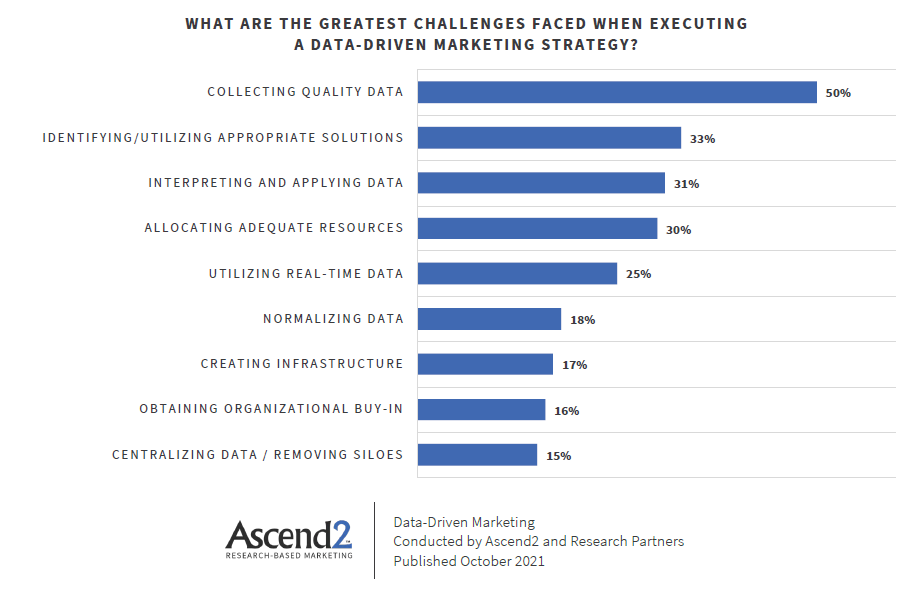It is widely accepted amongst marketers that making decisions backed by data can help improve marketing performance.
But how are marketers updating their data-driven strategies to navigate a changing landscape?
What better way to answer a question about data-driven marketing than to collect data on the topic.
Research firm, Ascend2, published the Data-Driven Marketing Survey Summary Report from the data collected in a survey fielded the week of September 20, 2021, and a total of 485 marketing professionals participated.
Marketing Technology News: MarTech Interview with Jason McClelland, CMO at Algolia
Here are a few noteworthy findings from the Asend2 research study and some tips and strategies on next steps.
Finding #1: Greatest Challenges
Half (50%) of marketing professionals surveyed find that collecting quality data is the greatest challenge to executing a data-driven marketing strategy. Identifying the right solutions to execute a strategy is also a top challenge for one-third (33%) of those surveyed. Removing data silos is the least reported challenge amongst marketers who might be gaining better access to solutions that help centralize data.

Why is data quality important? IBM estimates that bad data costs the U.S. economy $3.1 trillion per year. Part of that is costs in marketing. Beyond the direct costs is missed opportunities as a result of bad data.
The factors that contribute to quality data are:
- Accuracy
- Validity
- Completeness
- Timeliness
- Relevancy
- Consistency
With quality data you can identify prospects that match your Ideal Customer Profile (ICP), provide them appropriate content, messaging, and offers. With poor data quality you miss opportunities and limit your ability to optimize your marketing programs.
Tip: Take the time to fix your challenge with data quality and all your data-driven marketing programs become more effective. Here are three ways to improve marketing data quality:
- Validate contact data as it is collected.
- Assign data quality responsibilities.
- Integrate sales and marketing data.
- Embrace marketing technology to improve data quality.
Finding #2: Making Effecitve Decisions
Marketers have a mostly positive perception of their ability to make effective decisions based on customer data. A 79% majority of marketing professionals surveyed said they are satisfied to some extent with their competence at applying customer data strategically to make better marketing decisions. Only 17% report dissatisfaction to any extent when it comes to their team’s data-driven capabilities.

Company leadership requires that their marketing team make decisions that are supported by data. With data, marketers can determine where to spend marketing budget, what programs are working, what programs are not working, and how to optimize programs. Data gives marketers the opportunity to follow a systematic, data-driven, process. Here are the steps:
Marketing Technology News: MarTech Interview with Deepak Anchala, Founder and CEO at Slintel
- Evaluate
- Analyze
- Strategize
- Monitor
- Report
- Repeat (optimize)
Finding #3: Most Useful Applications
Data can be applied to a strategy throughout the marketing funnel and across a wide variety of marketing channels. While personalization is the most reported area for data-driven marketing use, marketers also say that email, content, and product or services development are also areas where they are seeing the most impact according to 38%, 36%, and36% of those surveyed, respectively.

Any marketing tactic can be improved with a data-driven marketing mindset. For example, an email marketing plan with a data-driven focus looks like this:
- Collect more data. A centralized martech stack will help with this process.
- Create segmented lists.
- Personalize your emails.
- Use automation to improve the user experience.
- Send mobile friendly emails.
- Test copy, design, the call-to-action (CTA), and CTA buttons.
- Measure campaign success. Determine the key performance indicators (KPIs) you will use to make decisions.
Finding #4: Improving Your Data-Driven Strategy in 2022
In the coming year, marketers will be focusing their efforts on improving personalization and the quality of data to better their data-driven strategy according to 45% of those surveyed. Utilizing more available data is also a top initiative to address in the year ahead for 38% of marketing professionals.

Tip: Here are 6 steps to improving personalization:
- Get more quality
- Generate your Ideal Customer Profile (ICP).
- Determine the pain points of your ICP.
- Align your content to the pain points of your ICP.
- Personalize everything: emails, ads, landing pages, content, etc.
- Personalize the overall customer experience.
Finding #5: Budget Trends for 2022
Data-driven marketing budgets are trending up in the year ahead. Nearly two-thirds (65%) of marketers are planning for a moderate increase in their dedicated data-driven marketing budget in the coming year, while 17% report their budgets dedicated to data-driven marketing will be increasing significantly. Another 17% predict a budget decrease to some extent.

Tip: Use the chart above to support your budget request for the coming year. It is important that you have the budget to support the data-driven marketing strategy that you plan to implement in 2022.
Marketing Technology News: MarTech Interview with Rachel Meranus, CMO at Transfix











